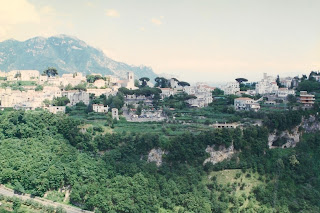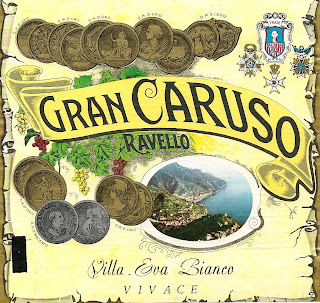What a glorious time we spent in and around Ravello! Called the jewel of the Amalfi Coast, it's hardly undiscovered. But we hadn't heard of its Music Festival.
After our plans were made to go there, I saw a picture which showed the setting of the concert. It was outdoors with the Mediterranean and Amalfi Coast and its environs in the background. Unbelievably beautiful, I couldn't wait to go and experience it.
So off we went by bus from Salerno to Scala. Changing buses in Amalfi, we passed Atrani with its colorful tiled dome of the church of San Salvatore. The bus turned and it started climbing a winding road into the mountains. Around every turn, there were stupendous views of the sapphire-colored sea. Or the vineyards arrayed in terraces on the hills were seen plunging straight down to the coast.
We went through a narrow gorge, which broadened somewhat into the Dragone Valley. The bus stopped first at Pontine, a small, hilltop village.
Then it passed the turnoff to Ravello and curved around to Scala across the ravine from Ravello.
The bus driver kindly dropped us at the doorstep of our hotel, the Villa Giuseppina. We climbed down a flight of stairs, which led to an outdoor terrace. Our eyes beheld such a beauteous view, the whole town of Ravello. I could recognize the towers of the Duomo and the Villa Rufolo, which I had seen in postcards. We quickly climbed down further and were entranced by the different levels or terraces of the hotel.
One had a large swimming pool, another a small restaurant and bar, and still others just providing places for the guests to recline. Then they could take in the views of the vineyards, the water, Scala and Ravello. Potted geraniums and flowing bougainvillea were in abundance everywhere. The genial owner greeted us as if we were members of his family. He was the epitome of a courtly, hospitable Italian seignor. He inquired if we needed anything. We told him we hadn't had lunch.
While we sat and soaked up the sun, his staff prepared a delectable pasta dish for us. He introduced us to his daughter who brought forth a pitcher of white wine, which she told us she had made herself. The flavor was marvelous and I was in awe of what they just took for granted. No one I knew ever made any wine!
After lunch, my traveling companion climbed up to our room on the top floor of the hostelry. He called me from the balcony to come see the view. It was so high up that not only could we see Ravello but also the coastline and glowing water beyond. We sat out on our balcony thinking how fortunate we were to be in this lovely place.Scala is one of the three towns, which made up the Amalfi Republic formed in 839. It reached its golden age over a thousand years ago. Scala had two castles, one situated on the top of the mountain, the other on a peak overlooking the sea. Plundered and burned by Robert Guiscard in 1073, it recovered only to be almost destroyed again by the Republic's arch-enemy, Pisa, in the years 1135 to 1137.
One of its claims to fame is that it is the birthplace of Fra' Gerardo Sasso. He ran a small inn in Jerusalem for pilgrims who came to that city. He founded the Order of the Hospitallers or Knights of St. John, which later became the famous Order of the Knights of Malta who ruled over that island for countless years.
We changed clothes for the concert and walked into the small town of Scala to catch the bus to go to Ravello. The cathedral door was open so we stopped in for a brief visit to this old edifice dedicated to San Lorenzo. Its pretty painted ceiling, white walls and chapel full of cherubs pleasantly surprised us with its loveliness.The bus took us along the curving road to Ravello and dropped us off near the main piazza, where we found out that practically the whole town is just for pedestrians, no cars allowed. Ravello was founded as a Roman colony for the wealthy. It was considered the most enchanting spot on the coast, which is the most beautiful in Italy. So wrote Boccaccio in his famous work, The Decameron. He even tells us that one of these extremely rich men was named Landolfo Rufolo. I wonder if there is any connection between him and the Villa Rufolo where the concert is being held.
Ravello has conserved its monuments over the ages. These attract many visitors as well as celebrities. We thought we might see some tonight. There have been plenty in the past. D. H. Lawrence, Greta Garbo who came here with her lover Leopold Stokowski, Jacqueline Kennedy, Gore Vidal who was made an honorary citizen, and King Vittorio Emanuele III who signed his abdication here in favor of his son Umberto II.We first toured the Duomo, which was named after Ravello's patron, San Pantaleone, an obscure martyr. Dating to the 12th century, it has some of the first bronze doors made in Constantinople, mullioned windows and a pulpit with superb mosaic work. There is a reason why Ravello has been called a treasure house of medieval art.
Now the Villa Rufolo beckoned me. Built in the 11th century in the great period of the Amalfi Republic when there was trade with Sicily, the Arab world and even Constantinople, it bears the mark of exotic other cultures. For fans of Wagner, of which I am one, it is of special importance. Wagner had come here seeking a place that would suit him as the imaginary setting for the second act of his opera Parsifal. He left a note in the guestbook on May 26, 1880, saying the magic garden of Klingsor has been found.It really is lovely even in its half-ruined state. We went there early so we could walk around the garden and take pictures before a crowd of people arrived. It was filled with palm trees, bougainvillea, fountains, architectural fragments, and flowers everywhere, always with resplendent views of the coastline and Mediterranean as a backdrop. Ravello has been called a balcony overlooking the Amalfi Coast and from here, you could certainly see why. It has a natural setting that has few equals in the world.
We left and had dinner at the Caruso Belvedere, a gracious villa opened as a hotel over a hundred years ago by the grandfather of the present owner. He was a cousin of the famous opera singer Enrico Caruso. On its premises are lovely flower gardens but more importantly, a well-tended vegetable garden and its own vineyard. We had a bottle of its wine, which has a beautiful label with grape vines, coins and a view of the coast by Ravello. It is called Gran Caruso. This was accompanied by a meal of delectable seafood.
The concerts start late here, at nine o'clock. So it was dark by the time we went back to the Villa Rufolo. In its 44th season, the Music Festival this year ran from June 7 to July 18. There were 22 scheduled concerts which featured a wide assortment of European talent such as the sinfonia of Valencia, musicians from Salzburg, the ballet from Monte Carlo, the Philharmonics from Poland and Vienna as well as various groups from all over Italy.
The concert started promptly and we sat back and enjoyed the beautiful strains of the all-Schubert offering. Listening to great music in such a visionary, dreamlike setting was a tremendously satisfying and exciting experience for us. What a remarkable endeavor. I highly recommend it to everyone.We took a cab back to Scala and our wonderful host was waiting for us to make sure that we got home okay. What a perfect day!










No comments:
Post a Comment